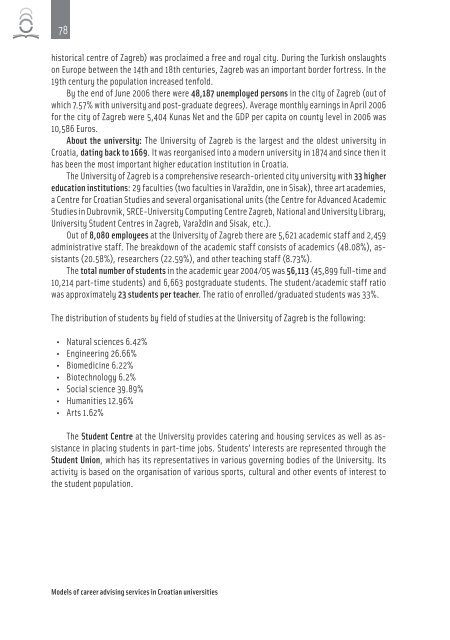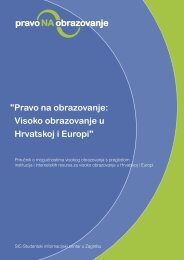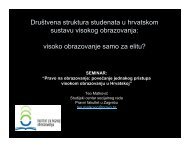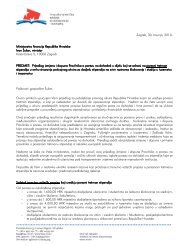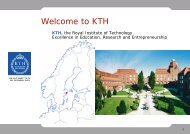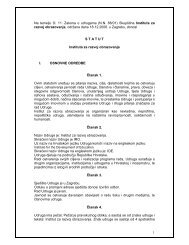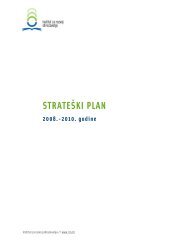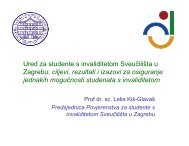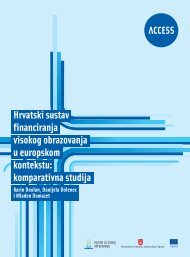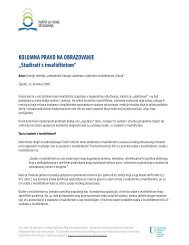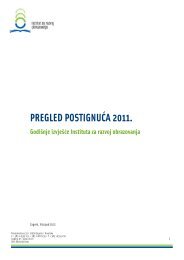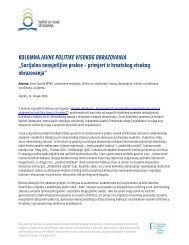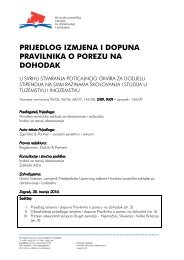Download handbook, PDF format (English) - Institut za razvoj ...
Download handbook, PDF format (English) - Institut za razvoj ...
Download handbook, PDF format (English) - Institut za razvoj ...
You also want an ePaper? Increase the reach of your titles
YUMPU automatically turns print PDFs into web optimized ePapers that Google loves.
78historical centre of Zagreb) was proclaimed a free and royal city. During the Turkish onslaughtson Europe between the 14th and 18th centuries, Zagreb was an important border fortress. In the19th century the population increased tenfold.By the end of June 2006 there were 48,187 unemployed persons in the city of Zagreb (out ofwhich 7.57% with university and post-graduate degrees). Average monthly earnings in April 2006for the city of Zagreb were 5,404 Kunas Net and the GDP per capita on county level in 2006 was10,586 Euros.About the university: The University of Zagreb is the largest and the oldest university inCroatia, dating back to 1669. It was reorganised into a modern university in 1874 and since then ithas been the most important higher education institution in Croatia.The University of Zagreb is a comprehensive research-oriented city university with 33 highereducation institutions: 29 faculties (two faculties in Varaždin, one in Sisak), three art academies,a Centre for Croatian Studies and several organisational units (the Centre for Advanced AcademicStudies in Dubrovnik, SRCE-University Computing Centre Zagreb, National and University Library,University Student Centres in Zagreb, Varaždin and Sisak, etc.).Out of 8,080 employees at the University of Zagreb there are 5,621 academic staff and 2,459administrative staff. The breakdown of the academic staff consists of academics (48.08%), assistants(20.58%), researchers (22.59%), and other teaching staff (8.73%).The total number of students in the academic year 2004/05 was 56,113 (45,899 full-time and10,214 part-time students) and 6,663 postgraduate students. The student/academic staff ratiowas approximately 23 students per teacher. The ratio of enrolled/graduated students was 33%.The distribution of students by field of studies at the University of Zagreb is the following:•••••••Natural sciences 6.42%Engineering 26.66%Biomedicine 6.22%Biotechnology 6.2%Social science 39.89%Humanities 12.96%Arts 1.62%The Student Centre at the University provides catering and housing services as well as assistancein placing students in part-time jobs. Students’ interests are represented through theStudent Union, which has its representatives in various governing bodies of the University. Itsactivity is based on the organisation of various sports, cultural and other events of interest tothe student population.Models of career advising services in Croatian universities


